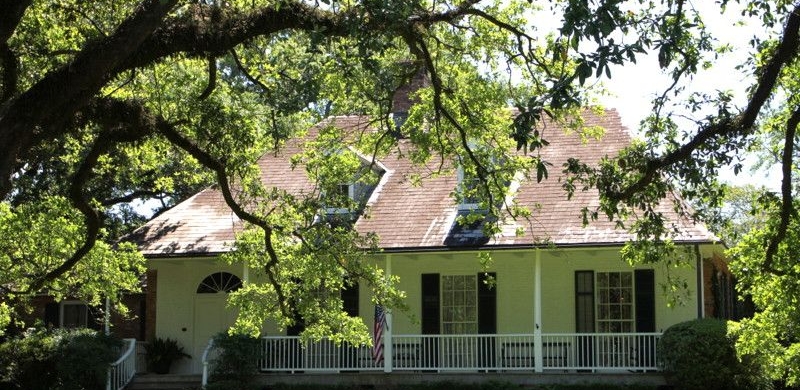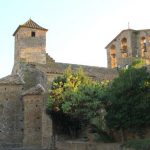Living in an A. Hays Town Home in Lafayette, Louisiana
Robbie Mahtook, Lafayette attorney and owner of A. Hays Town home, originally owned and built by Horace Rickey.
By Stephanie M. Chambers
A. Hays Town: The Mahtook Residence in Lafayette, Louisiana
While in Louisiana this spring to study the residential architecture of A. Hays Town, Texas architect Steve Chambers spent several days in Lafayette, Louisiana. Chambers visited the home of Robert and Judy Mahtook, located between the ULL campus and the Oil Center. The home was originally built by the Oil Center contractor, Horace Rickey, for his own family. It was one of the first homes in the city designed by A. Hays Town. The original home of Maurice Heymann, developer of the Oil Center, was also designed by Town and gifted to the university by the family and is incorporated into the campus buildings of ULL. The Heymann home predates the Mahtook home. A comparison of the two homes demonstrates A. Hays Town’s gradual evolution from French Norman with International modern influences (The Heymann Home) to his distinctive embrace of the Louisiana folk vernacular (The Mahtook Home).
Lafayette, The Heart of Acadiana
Lafayette is located in south central Louisiana and serves as an economic center in Louisiana. The region’s legendary joie de vivre and Cajun and Creole cultures create a unique environment for work and play. A recent issue of Southern Business and Development magazine named Lafayette as a Top 10 place in the South for the “creative class,” citing Lafayette’s risk-taking spirit and technological advantages. Lafayette has one of the most robust economic infrastructures in the country: a flourishing petroleum industry, a well-trained workforce, unmatched quality of life, and a favorable environment for their business community. There are many colorful festivals celebrating food, wine, music, and “letting the good times roll.”
Concentration on Residential Design
Mr. Town often commented that his measurement and documentation of the historical buildings for the government throughout the South aided him greatly in the development of his particular style of home design based on Louisiana folk architecture. Moving back to Louisiana in 1939, Town started his own architectural firm in Baton Rouge. Eventually, he designed a home for a friend and liked it so well that he began to concentrate on residential design, which seemed “a more satisfactory outlet” for his talents.
The Architect Develops His Own Regional Vernacular
The Maurice Heymann Homestead, on the campus of ULL, represents an earlier Town design with its French Norman and modern International Style influences
Town’s 70-year residential design career provides us with an exemplary model in which to study the evolution of 20th-century American architecture, which spanned from the domination of Beaux Arts formal design, through European Modernism, to a period where areas of American society became appreciative of their own regional influences. A. Hays Town’s remarkable talent and logic enabled him to assimilate a wide variety of influences from his education and early career as well as those presented to him through his recording the historical examples within his region. It contributes both to an understanding of the potential use of vernacular traditions in general, and specifically, those of the rich architecture of Louisiana’s captivating history.
His earlier home designs borrowed from American Colonial and Georgian architectural styles. As his career progressed, he began developing a more unique style influenced heavily by Louisiana’s Spanish and French architecture. Interior courtyards and fountains reflect the Spanish tradition, while raised exterior stairs and French doors reflect the Creole influence of New Orleans. He also adapted his home designs to the climate of southern Louisiana with the implementation of large roof overhangs, the abundance of breezeways, and cross-ventilation for air circulation.
A. Hays Town Interior Design
Town’s involvement in the selection of interior materials, colors, and even furnishings was extensive, going as far as to recommend a certain type of dog to accent the house. Town was one of the first architects to salvage old building materials and incorporate them into new houses, giving his homes a comfortable, well-worn elegant feel. He would often search abandoned warehouses and rice mills for floorboards, fireplace mantels, or flagstone, handpicking the individual elements that would eventually be incorporated into his architecture.
The Mahtook Home demonstrates all of the mature design decisions that came to define the A. Hays Town style. The construction, materials, proportions, and details all reflect his regional influences from climate to folk culture and create his distinctive aesthetic expression. It is confidently related to the preservation and creation of this intriguing region and its beguiling cultural identity. Robbie and Judy Mahtook both concur when asked how it feels to live in this historical residence, “we feel an immense pride, yet a strong responsibility, to maintain very careful stewardship of this home. We want the house to be a place where we and our children can live and entertain guests, but we also want to honor the legacy of this gifted man and his beautiful architecture.” Steve Chambers, a Texas architect, admires the depth of respect the Mahtooks have for their home and the lengths to which they are going to protect this cultural treasure for the Lafayette community, currently and for future generations.
For Part One of A. Hays Town, click this link: A. Hays Town Regional Architecture
In the first gallery, below, the A. Hays Town design for the Heymann Home shows the influences of French Norman and modern International Style of the 1930’s in its details and proportions.
In the second gallery, below, The Mahtook Home demonstrates the Town evolution from French and modern international style influences to implementation of the Louisiana folk vernacular with its deep porches, breezeways, recycled materials, Hays-designed light fixtures and drapery. The drapes were double-sided with the more ‘plain folk’ pattern turned to the street and the elaborate hand-dyed patterns facing the interior of the home’s living area. Lush landscape utilizes indigenous plant materials in a more casual pattern rather than a formal French garden. The family room has a simple stair from the upper floor ‘garconnier’ as opposed to a grand stair in the entry.














